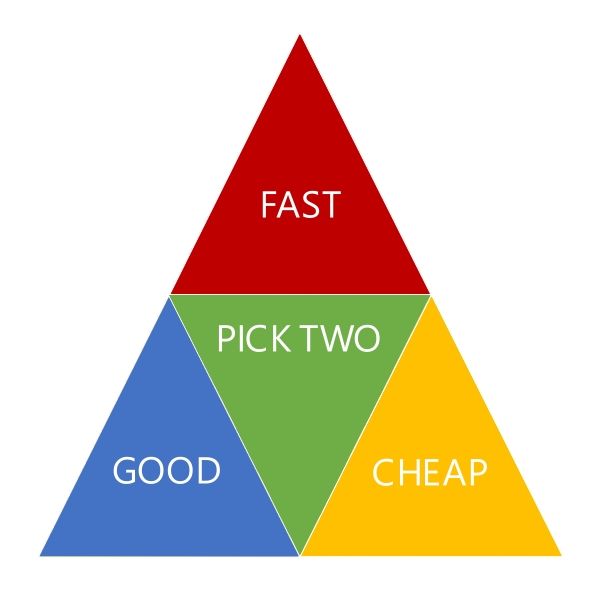The Iron Triangle
How to manage your client’s or team’s expectations as a compositor…

How to manage your client’s or team’s expectations as a compositor.
A key part of your job as a compositor is to manage your client’s or team's expectations.
You could be a star compositor but if no one would know which shots to expect from you; at what level of quality; and when, then you probably wouldn't come across as one.
Regularly communicating updates, concerns, ideas, or requests with your client or Supervisor/Production will land you in their good books and take a lot of pressure off of the project.
And so keeping an open line of communication with the key people involved is crucial for the smooth running of a show. When everyone knows what to expect, it's much easier to plan and schedule the workload. Which is exactly why managing expectations is so important.
To do that well, it’s useful to be familiar with The Iron Triangle and the major constraints that you will encounter on a project:
Pick Two
The Iron Triangle is a concept from Project Management which lays out a system of triple constraints:

The Iron Triangle.
When pushing to excel in one area, you’ll be constrained by one or both of the other two components of the triangle.
For example, if you want to make an outstanding piece of work, the quality will be limited by the project’s deadline and/or budget.
At most, you can crank up two out of the three options in the triangle.
So if you want great quality work delivered quickly, then it won’t be cheap. Overtime, weekend work, additional (and potentially more senior) manpower, as well as extra render farm hours will need to be employed, and other production costs will come into effect.
A one-man operation working on a solo project for two years can indeed produce excellent quality work with a small budget. But it will take two years. If he wanted to do it faster, he wouldn't be able to do it alone, and/or with the same low-cost tools.
So there is a tradeoff, and you will have to choose what to sacrifice:
- Time.
- Quality.
- Or Money.
There is obviously more nuance to it, but that is essentially what it boils down to.
How this all plays out in practice is not always immediately obvious, and at times you may be asked to do more than what is reasonable:
Great Expectations
The client or the Supervisor/Production may sometimes request a push in all three corners of the triangle – often unknowingly.
And if that happens, it’s up to you as a compositor to manage their expectations for what is reasonably possible to achieve within the given timeframe.
To understand why this situation can happen, let’s look at how the work is planned out for a project at a typical VFX company:
The Bidding Process
Before a show or sequence is awarded to a company, it goes through a bidding process.
Production and the Supervisors analyse every shot and estimate how long it will take to complete. They look at the editorial reference, the VFX description, and any supporting references and information in order to determine:
- What exactly needs to be done in the shot.
- How complex the work is.
- How many days are needed to do it.
They do this exercise for every discipline:
- Matchmove (Camera Track and Body Track)
- Modelling
- Rigging
- Texturing
- Animation
- FX
- CFX (Character/Creature FX – such as muscle, hair/fur, or cloth simulations)
- Crowd Dynamics
- Layout
- Lookdev
- Lighting
- Roto
- Prep
- Matte Painting
- Compositing
(Depending on the studio and project, there may be more tasks to bid – such as Concept Art, Previsualisation, or R&D).
And then an extra buffer is added for safety. Because unforeseen issues do tend to crop up more often than not.
Production also provisionally communicates with Crewing to coordinate the manpower required to fulfil the bid. For example, how many compositors would be needed, of which levels of seniority, and when, in order to actually complete and deliver the work on time.
Once the bid is approved, the work is scheduled out to the best of Production and the Supervisors’ ability. But it is incredibly difficult to predict the future accurately. So the plans are constantly adjusted over the course of the project.
That means, some of your targets may not be realistic at first. There may be a delay in CG that has a knock on effect on your comp, for instance. Or, the work may be more involved than anticipated, and you need more time to complete it.
If you have a target to deliver a shot by the end of the week and you feel that it’s not achievable, then do speak up sooner rather than later.
The best thing is to communicate any concerns early on, so that they can be dealt with appropriately. Production can chase other departments, allocate more resources, or reschedule the target. The schedule will then be updated as needed and any changes communicated to the client.
If you spend the whole week working on the shot without voicing your concerns, and only tell Production on Friday morning that it won't be ready for delivery – that's a much worse scenario for everyone.
Simply letting the team know on Monday or Tuesday that finishing the shot on time may be unlikely – and then updating them along the way throughout the week – is much more helpful.
Even if you were wrong in your initial estimate, and you did manage to complete the shot on time, that would just be a huge bonus point.
Which leads to the next two points (that I also covered in How To Get Hired As A Compositor – Part 8: Excel In Your New Role, but are definitely worth revisiting):
Underpromise And Overdeliver
It’s important to be realistic regarding targets in order to plan well and deliver the work on time.
And so it’s better to underpromise and overdeliver, than the other way around.
When judging how long a task is going to take, err on the side of caution and add at least an extra 30% or more to your estimate. Very often, things will take longer to finish than you initially think.
There could be unforeseen issues which cause delays, for example:
- The task turns out to be more difficult than anticipated.
- The render farm gets slammed by other projects, and there is a queue.
- Other departments don't deliver vital material on time, for example roto/prep, CG renders, or matte paintings.
- Nuke keeps crashing for some reason and you have to troubleshoot.
- You spot something else which needs to be done on the shot (that wasn’t briefed).
- You get additional client notes.
- The server goes down or you lose access to your workstation for a period of time.
- Or, some other unexpected problem which needs to be fixed.
When we give time estimates, we tend to visualise ideal conditions. While it's great to be optimistic, make sure that you also remain realistic. Remember to add a generous buffer to account for things taking longer than expected.
By underpromising, you set yourself up for success.
Let's say that you think a small task will take two hours to complete. When asked, you could for example give an estimate of half a day.
If everything goes well and it ends up only taking two hours like you thought, that's fantastic – you can now deliver early. The Supervisor/Production/client will be thrilled.
If something goes wrong and it actually takes three or four hours, that's not a problem – you have already managed their expectations to account for that, and they will be happy that you deliver on time.
And if it goes terribly wrong and the task ends up taking you five or six hours to complete, that’s at least not as far off the mark as if you would have given a two hour estimate.
By being realistic regarding targets and not underestimating the time something will take, everyone will benefit. Production can plan ahead properly, client expectations can be managed well, and you will have less stress on delivery days.
Everyone's happy.
But it all comes down to clear communication:
Communicate, Communicate, Communicate
'Communication is key' is a common saying for a reason.
Being able to clearly and effectively communicate with others is vital in our industry. It’s so important to get on the same page for anything related to the work:
- What’s the brief and context for the shot?
- Which direction should you take the shot or sequence in?
- What’s required to make something work?
- What’s the current progress?
- Which issues are you facing?
- Are you waiting for something else before you can start, or continue?
- When is something expected to be delivered?
- Who is responsible for what?
And so on.
There are so many different things that need to be communicated clearly on a daily basis. The success of a project directly relies on good, unambiguous communication between all of the team members.
It's not always easy. We’re all somewhere along the spectrum between introverted and extroverted. Some people might have a harder time freely speaking up during dailies or in team briefings. Or they might be afraid of giving honest critique to friends. Writing might be their strength, versus having a conversation.
Others might prefer to bounce ideas off each other in person, or even struggle with for example dyslexia and subsequently with written notes and emails.
Playing to your strengths while at the same time accommodating others' can be tricky but it is necessary for the smooth running of the team. Remember, it’s much better to have a slightly awkward conversation than to continue working blindly or heading in the wrong direction. The majority of the time, you’ll find that everyone is friendly but you have to go first.
Flag any issues early on, and agree on a way forward. Discuss with the CG team which passes need to be rendered, or what the layer naming should be (if not standardised). Talk with the DMP artist about what the plan is for the shot and how you can best support each other. Keep Production in the loop so that they can help follow up and keep track.
Communicate with your Lead, Supervisor, and/or Production:
- About the work that you have finished – so they stay in the loop.
- About any concerns you have with your targets or your progress – so they can reevaluate the schedule.
- If you have received conflicting notes on a shot – so they can provide clarification and direction.
- If you have received too many requests – so they can set priorities.
- If you are waiting for something – so they can help chase the relevant people.
- To follow up about something previously discussed – so they have the latest information.
- If you have an idea (or a better idea) for a solution or an approach to a problem – so they can decide on the best way forward.
- To simply bounce ideas.
It's better to over communicate than to leave out important information. Just keep the first tip in this article in mind: try not to bombard your Supervisor/Production with questions if the solution is a simple Google or email search away.
Speaking of solutions:
Be Solution-Oriented
Working as a compositor is a constant cycle of adapting and communicating.
You’ll face different challenges on a daily basis. And you won’t always know how to solve them.
When you do get stuck, please approach the person you ask for advice with a solution-oriented mindset, instead of a problem-oriented one.
Instead of only saying, 'I have this, this, and that problem..' – briefly explain which solutions you have tried and which methods haven’t worked in your attempts. Show that you have actually tried to figure it out, and are not just lazily asking for them to do the thinking/work for you.
The same goes for any requests you receive. If you can’t currently accommodate them, avoid just stating the problem (e.g. that you have enough work on your plate), but instead try to offer a solution.
For example, if a target has been moved forward:
‘Do we need to deliver a version by tomorrow? Ok, we can do it if I could get some help doing the patch work in this area, and someone to roto this part, while I finish up the keying work.’ Or, ‘Yes, I’ll prioritise finishing this shot today but would it be okay then that my other targets get pushed a bit?’
It’s a more friendly and helpful way of working together.
And it gets more and more important the further you progress:
The Progression Of A Shot
In relation to The Iron Triangle, the work on a shot typically moves in stages from Fast → Good.
And as the shot is progressing, different versions will be sent to the client to make sure everyone is on the same page – again to manage expectations.
A shot typically goes through four different stages:
First Look
The First Look version of the composite is usually just a 'slap comp':
A quick version with all the various elements put together with little to no grading, integration work, or refinements applied.
This version is made in order to confirm:
- That you have everything you need to forge ahead with the compositing work on the shot. You have the scan, retime, repo, camera, CG, lens distortion, geometry, DMP, Roto, Prep, edit reference, and/or any other elements you require. And all the render passes you need for each.
- That everything works as expected technically. There are no problems with any of the elements mentioned above, such as missing or corrupt frames.
- That everything looks as expected creatively. There are no issues with the lineup, the CG is lit from the correct angle, objects are moving in the right direction, etc.
- That it all works as expected editorially. You have the right timing and framing of the shot, and everything matches up to the editorial reference.
This First Look version is meant to be Fast, only. You're just slapping everything together to make sure that you can safely continue working.
It's to avoid spending time working up all the details, only to find out that something is fundamentally wrong with the shot and then it all needs to be redone.
WIP
The Work In Progress version of the composite is exactly what it says on the tin:
A version where the creative work has progressed to a point where the shot is starting to take shape, and you are happy to show it to the client for initial feedback and further direction.
You and often the other departments (CG, DMP, etc.) have developed the look and creative aspects of the shot, but not sunk much time into fine details and edge work. Broad strokes only.
If it’s a straightforward shot, you may only need to show one WIP version before moving on to the next stage.
However, if there is more involved creative look development, you may have to send multiple WIP versions until the client is happy with the direction in which the shot is heading.
While we are definitely moving towards Good in the WIP stage, we are still fairly Fast and nimble. And that’s important, because it's much cheaper to change things in the Fast stages, than later on.
Once the WIP has been approved and the client is happy with how everything is going, you move to the next stage:
Creative Final
The Creative Final version of the composite is fully refined creatively.
You address any last creative notes the client might have, and get the look of the shot dialled in exactly.
The colour grading, integration work, and most of the edge work is all complete. There are no distracting or easily noticeable technical issues, such as popping or major artefacts. And, you're happy to present the shot to the client as the final look.
You've collectively moved the shot almost as far as it goes towards the Good corner of The Iron Triangle.
Tech Final
The Tech Final version of the composite is the home stretch.
The shot has been creatively approved, and only the quality control remains. This is where you check that the grain is matching, that the edges are all looking good, and you make sure that all the technical aspects of the composite are up to standard.
Check out Tech Check Checklist For Compositors for a rundown of everything to check.
If you have been working in an organised and deliberate way – managing grain mattes, not taking any cheap shortcuts or making poor structural compositing decisions, etc. – the Tech Final should only require minor tweaks to complete.
At each stage, even at the Tech Final level, you may get a client request to make a significant change to your shot.
Knowing When To Push Back
As mentioned previously, each shot goes through a bidding process.
During that process, written assumptions should be made to ensure that the work stays within the original scope throughout the project. With free reigns, the client could easily continue to ask for significant modifications or additions, ballooning the workload.
And so it’s important to stick to the bid. You want the VFX company you’re working for to be profitable, and not take a loss on the project. And at the same time you want the conditions to be fair for all parties.
That means, if you’re asked to do work outside of the original scope, that should incur an additional cost. If they haven't been already, any disproportionate client notes should be cleared with Production before they are actioned.
And even if the work is within the agreed upon scope, be transparent if a target is unrealistic. Flag it with the Supervisors and Production as soon as possible.
Part of pushing back and managing expectations is also about setting professional boundaries. For example, ‘I’m unfortunately not able to work on Saturday, but let's instead..’.
Having clear expectations builds trust both within the team and between the team and the client. It establishes accountability, and when everyone acts with the same understanding of the duties and timelines, productivity increases which leads to a better outcome.
When that happens, you’re efficiently navigating The Iron Triangle.
I hope you found this article useful. For more productivity tips & tricks, see Productivity.



